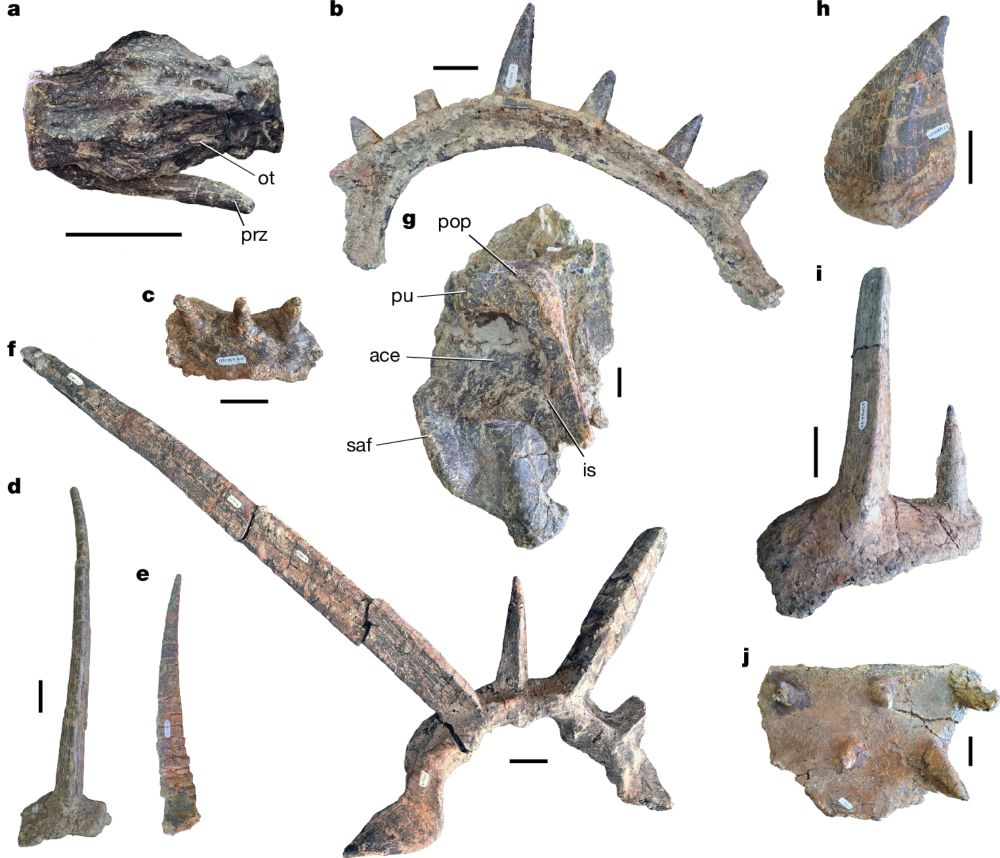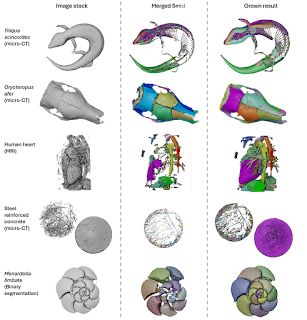Lastly, our results emphasize the importance of performing complete adductor muscle reconstructions when running FEAs, and analyses that simplify muscle vectors to single points will possibly miss key data on functional performance. [11/11]
01.10.2025 18:21 — 👍 0 🔁 0 💬 0 📌 0
Size mediated resource partitioning is common in modern systems, suggesting that although hadrosaurids, ceratopsids, and ankylosaurians were specialized for different plants, within-group partitioning was subtle and ecological signals cannot be found, apart from size. [10/11]
01.10.2025 18:21 — 👍 0 🔁 0 💬 1 📌 0
Our results have important implications:
Resource partitioning between hadrosaurids was size mediated, where similarly sized animals had similar potential for food processing. Larger hadrosaurines had stronger bites than lambeosaurines, and likely had a wider diet breadth. [9/11]
01.10.2025 18:21 — 👍 0 🔁 0 💬 1 📌 0
This difference in stress distribution is likely a product of extreme cranial anatomy in Corythosaurus, where the lambeosaurine cranial crest resulted in a change to cranial biomechanics. Further testing of other lambeosaurines is underway to explore this possibility. [8/11]
01.10.2025 18:21 — 👍 0 🔁 0 💬 1 📌 0

Curiously, our analysis also reveals that Gryposaurus and Corythosaurus skulls dissipated stress very differently from each other. Gryposaurus had the typical tetrapod stress distribution, but Corythosaurus differed in experiencing very little stress in the snout. [7/11]
01.10.2025 18:20 — 👍 0 🔁 0 💬 1 📌 0
These differences in muscle size and efficiency mean similarly sized Gryposaurus and Corythosaurus had similar bite forces. However, Gryposaurus could attain much larger skull sizes than Corythosaurus, meaning adults had higher bite forces and could eat tougher plants. [6/11]
01.10.2025 18:20 — 👍 0 🔁 0 💬 1 📌 0


Our analyses reveal biologically relevant differences in the arrangement of the jaw muscles in these animals, where Gryposaurus had proportionately larger jaw muscles than Corythosaurus, but those of Corythosaurus had better leverage and could impart a greater force. [5/11]
01.10.2025 18:20 — 👍 0 🔁 0 💬 1 📌 0

Here, we sought out to test whether there are differences in feeding mechanics between the hadrosaurine Gryposaurus, and the coexisting lambeosaurine Corythosaurus from the DPF using Finite Element Analysis. [4/11]
01.10.2025 18:19 — 👍 0 🔁 0 💬 1 📌 0
Hadrosaurids are particularly interesting when discussing adaptations for feeding because of their high diversity, complex feeding system, and the frequent co-occurrence of multiple hadrosaurid species within an ecosystem. [3/11]
01.10.2025 18:19 — 👍 0 🔁 0 💬 1 📌 0
The DPF is unusual in the large number of herbivores that coexisted, and is commonly explained by resource partitioning. Evidence for resource partitioning between major groups has frequently been found, but evidence within groups, like hadrosaurids, has been subtle. [2/11]
01.10.2025 18:18 — 👍 1 🔁 0 💬 1 📌 0

After an incredibly long gestation period, I have a new paper out reviewing all the data and evidence we have on the pterosaurian uropatagium. Full link to the paper is in the blogpost linked below:
archosaurmusings.wordpress.com/2025/09/16/t...
16.09.2025 06:52 — 👍 71 🔁 17 💬 2 📌 0

Extreme armour in the world’s oldest ankylosaur
Nature - The ankylosaurian dinosaur Spicomellus afer possessed a tail weapon and uniquely elaborate dermal armour.
If you don't have access to Nature, but would like to read our paper on the new specimen of #Spicomellus, you can read it online at this link with no subscription: rdcu.be/eCJK3
27.08.2025 16:34 — 👍 72 🔁 30 💬 3 📌 1

This wild new instrument brings a dinosaur back to life
A new instrument called the Dinosaur Choir uses CT scans and 3D modeling to recreate actual the sounds of a Corythosaurus.
Ever wonder what dinosaurs might have sounded like? Courtney Brown and Cezary Gajewski developed Dinosaur Choir, a mix of palaeo and music that turns hadrosaurs into instruments. It was a blast to consult, this opens new doors for palaeo reconstructions...
www.fastcompany.com/91291997/din...
30.03.2025 13:53 — 👍 24 🔁 8 💬 0 📌 0
Oh groovy, our paper on the hindlimb biomechanics of the Triassic dinosauriform Lagosuchus is out! A quick thread for now. We uCT-scanned most of the existing skeletal material for this important outgroup to Dinosauria. We sorted through the elements and chose the best ones to make a 3D model from.
04.12.2024 20:07 — 👍 112 🔁 26 💬 4 📌 1

Figure showing diverse datasets analysed with SPROUT, including a skink skeleton, aardvark skull, human heart, concrete block, and foraminifera.
New paper! For all of you working with 3d scans (e.g. micro-CT, MRI), check out SPROUT, a rapid open-source tool for generating segmented and parcellated data, meaning your scans are separated into the individual elements without any manual labelling or training. www.biorxiv.org/content/10.1...
24.11.2024 13:09 — 👍 213 🔁 92 💬 10 📌 6
Thanks Ali!
25.11.2024 17:56 — 👍 1 🔁 0 💬 0 📌 0
Clarification: Hadrosaurus must be in Hadrosaurinae by strict clade definition, but here we mean in the traditionally conceived clade composition
25.11.2024 17:55 — 👍 0 🔁 0 💬 0 📌 0
We also hope that our dataset and multivariate comparisons may help identify isolated jaws and teeth, providing a new potential avenue for identifying microsite material to a finer resolution. [14/14]
25.11.2024 17:11 — 👍 0 🔁 0 💬 0 📌 0
With these analyses, we hope future studies will amend character states following our recommendations, and individual and ontogenetic variation will be better incorporated into character coding to construct more accurate phylogenies. [13/14]
25.11.2024 17:11 — 👍 0 🔁 0 💬 1 📌 0
Among these 5 problematic taxa, perhaps the most phylogenetically significant was Hadrosaurus, which was found to most likely to pertain to Hadrosaurinae with very high probability (0.996). [12/14]
25.11.2024 17:11 — 👍 1 🔁 1 💬 2 📌 0
Lastly, we were curious what impact these results would have on historically problematic iguanodontians, so we used our multivariate analyses to predict the phylogenetic placement of Hadrosaurus, Eotrachodon, ‘Trachodon’ cantabergiensis, Claosaurus, and Yamatosaurus. [11/14]
25.11.2024 17:10 — 👍 1 🔁 1 💬 1 📌 0

Our analysis came with some unexpected observations, most notably the presence of secondary ridges and rounded mammillations on the teeth of early diverging hadrosaurines like Brachylophosaurus and Maiasaura, features classically thought of as lambeosaurine. [10/14]
25.11.2024 17:10 — 👍 2 🔁 1 💬 1 📌 0
Secondary ridges and rounded denticles often co-occurred together in the same taxa, and are often present in lambeosaurines and absent in hadrosaurines. These characters may therefore be most useful when applied together. [9/14]
25.11.2024 17:10 — 👍 1 🔁 1 💬 1 📌 0

Next, we used multivariate statistics to evaluate how these characters delineate phylogenetic groups when used together. We found that they are accurate overall, suggesting that with modification they can be used reliably. [8/14]
25.11.2024 17:09 — 👍 2 🔁 1 💬 1 📌 0

The presence and shape of marginal denticles was the best of the 4 characters. Although individual variation is present, rounded denticles are almost exclusive to lambeosaurines and non-hadrosaurid iguanodontians, and wedge-shaped denticles are never seen in hadrosaurids. [7/14]
25.11.2024 17:07 — 👍 1 🔁 1 💬 1 📌 0

The presence of a single secondary ridge on the tooth is individually variable, with variation in their presence even on the tooth row of individual animals. The presence of a single ridge should be grouped with their absence. [6/14]
25.11.2024 17:06 — 👍 1 🔁 1 💬 1 📌 0

Tooth aspect ratio is a very poor character, and although broad phylogenetic trends are present, individual variation is huge and clear differences between clades are not present. This character should only be used if describing major differences in aspect ratio. [5/14]
25.11.2024 17:06 — 👍 1 🔁 1 💬 1 📌 0

Our results have big implications:
The number of tooth rows is almost entirely related to size, this character is only useful at separating hadrosaurids from non-hadrosaurid iguanodontians. Lambeosaurines and hadrosaurines do not differ allometrically. [4/14]
25.11.2024 17:05 — 👍 1 🔁 1 💬 1 📌 0
The Society of Vertebrate Paleontology is made up of university, museum, and public lands professionals, as well as artists, students, and others interested in VP. The society is organized exclusively in support of educational and scientific purposes.
Discover new research from across the sciences and highlights from the world's longest-running journal archive. Part of @royalsociety.org royalsociety.org/journals
PhD student in dinosaur anatomy, evolution and biogeography at UCL and the NHM London.
Entomology, paleontology, evolutionary ecology, science communication | currently a postdoctoral fellow at the Okinawa Institute of Science and Technology
PhD student, ecologist, likes bees 🐝
University of Toronto Scarborough 🇨🇦
ESO grad student rep 🪲
https://linktr.ee/janeansharkey
Palaeontology/Biology alumni @uoft, alumni @humbercollege. Masters in biology @uofg. 🏳️🌈🦕 🐚 Black/Indigenous lives matter. Dyslexic/ADHD/ Asperger's
Curator of Palaeontology and Geology at the Manitoba Museum and Adjunct Prof. at U of Saskatchewan Geological Sciences, using Cambro-Ordovician #fossils to illuminate early animal evolution (personal account)
All creatures great and small, mostly #TeamFish
PhD student @UofT EEB, evolutionary and behavioural ecology
she/they
Mostly posts about the art history of paleontology in museums. Exhibit developer at the Field Museum, opinions my own. Proudly from DC. he/him
Website: extinctmonsters.net
UMN palaeo grad student, rock eater, horse tooth measurer, book hoarder, impulse zoogoer | she/her 🏳️⚧️🏳️🌈 🦖 | Views my own
Vertebrate Palaeontologist and Collections Manager at OUMNH / @morethanadodo.bsky.social. Research areas: Mesozoic reptiles and sharks. Chair of @originalgcg.bsky.social. Anti-racism. She/Her
Scientist, author, polar wanderer.
Natural history scientific illustrator specialized in paleontology.
PhD student in vertebrate paleontology, focusing on biomechanics. Love dinosaurs and end-Cretaceous paleoecology. I also love herpetology, space, and love running tabletop RPGs.
Vertebrate Paleontologist studying early primates and their kin. Also enjoy going to the theatre and looking at art. Professor at University of Toronto Scarborough. She/her
MScR at Edinburgh studying ankylosaur brains, senses, and ecology. Lover of dinosaurs, dogs, the outdoors and sweet treats. BSc (hons) Zoology, Uni of Reading.
Visiting Assistant Professor at UC Davis. #Paleontology Research on dinosaurs, mammals, and life history. Avid photographer and cook. Learn more about my work at www.gregfunston.com
He/him
Vertebrate Palaeontologist, science communicator, and ethics advocate.
Woke ideals such as wanting happiness, peace, and healthy living conditions for everyone.
#Paleontology #MomInScience #Firstgenscientist. BLM 🏳️🌈Ally🏳️⚧️. Dutch/English



















